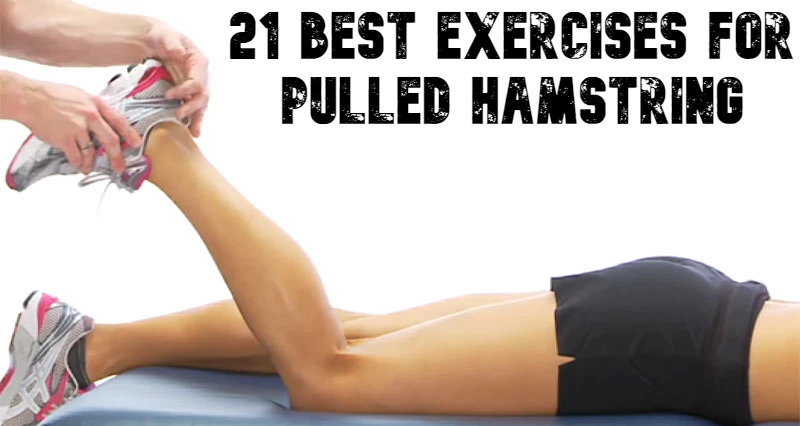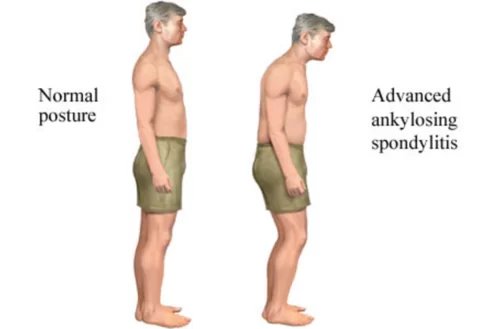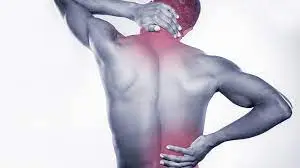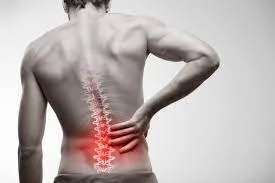21 Best Exercises for Pulled Hamstring
Table of Contents
Introduction
A pulled hamstring, or hamstring strain, can be a common injury that occurs when the muscles at the back of the thigh are stretched beyond their limits. Recovering from a pulled hamstring requires a careful balance of rest and targeted exercises to strengthen and rehabilitate the affected muscles.
In this guide, we will explore the best exercises to aid in the recovery of a pulled hamstring. These exercises are designed to gradually restore strength and flexibility to the injured muscles while minimizing the risk of re-injury.
Before starting any exercise program, it’s crucial to consult with a healthcare professional or a qualified physiotherapist to ensure the chosen exercises are appropriate for your specific condition.
Sports of a dynamic nature, such as sprinting, and jumping, and contact sports like Australian Rules football (AFL), American football, and soccer, where rapid eccentric contractions are frequent, are more likely to cause hamstring strains.
It is the most typical football injury. Recreational sports like water skiing and bull riding, where the knee is forcefully extended during injury, can also result in hamstring injuries.
The hamstrings consist of three muscles:
- The biceps femoris
- The semitendinosus and
- The semimembranosus
Epidemiology/Causes
- A hamstring muscle strain usually has an unknown cause. The hamstrings produce the most strain during the second half of the swing phase since they are the longest.
- During this stage, eccentric contraction of the hamstrings slows down hip flexion and lower leg extension.
- The hamstring muscle spindles reach their maximum activity at this stage. It is necessary to flex the hamstrings firmly and release the quadriceps muscles. The hamstring might tear as a result of an imbalance in the synchronization between these opposing muscles.
Predisposing Factors/Risk Factors
There are various proposed risk factors that may play a role in hamstring injuries:
- Older age
- Previous hamstring injury
- Limited hamstring flexibility
- Increased fatigue
- Poor core stability
- Strength imbalance
- Ethnicity
- Previous calf injury
- Previous substantial knee injury
- Osteitis pubis
- Among amateur Australian Rules football players, there was an inverse relationship between the occurrence of hamstring strains and increased quadriceps flexibility
- Players with particular polymorphisms, such as IGF2 and CCL2 (more especially, its allelic form GG), may be more susceptible to serious injuries and Should be involved in preventative initiatives
- Tight hip flexors
- Anomalies in the lumbar spine that were previously connected. It has been determined that kicking and performing core strengthening activities with straight legs may be contributing factors to lordosis.
- The anatomical explanation appears to be that the iliopsoas muscle group strengthens this muscle and is mostly used in activities like straight leg raises and sit-ups.
- Therefore, the player may be more vulnerable to damage from specific training regimens and sports activities that aggravate postural problems.
- Running and kicking cause the hamstrings to lengthen in tandem with hip flexion and knee extension; this lengthening may cause microscopic muscle injury or push the muscle to its mechanical limits.
- There’s a chance that the uncoordinated contraction of the biceps femoris muscle due to the dual nerve supply could be the cause of hamstring injury.
The difference in hamstring muscle architecture is a topic of further discussion. In comparison to the long head of biceps femoris (BFL), the short head of biceps femoris (BFS) has a substantially smaller cross-section area and longer fascicles, which enable higher muscle flexibility and lower the danger of overlengthening during eccentric contraction. In contrast to BFS, which experiences cumulative muscle injury and repeated over-lengthening of the fascicles, BFL has shorter fascicles.
Symptoms of Pulled Hamstring
A hamstring strain causes an unexpected, mild to severe posterior thigh soreness. It is also possible to characterize an impression as “popping” or tearing. Ecchymosis and edema can occasionally occur, but they might not show up for a few days after the incident.
Numbness, tingling, and weakness in the distal extremities are uncommon symptoms. Further research into sciatic nerve irritation is necessary in light of these symptoms. Whole tears and avulsion injuries might result in large hematomas or scar tissue.
Other possible symptoms:
- Pain
- Tenderness
- Loss of motion
- Decreased strength on isometric contraction
- Decreased length of the hamstrings
Three categories are used to classify hamstring strains based on the severity of discomfort, weakness, and range of motion loss.
- Grade 1 (mild): Only a small number of the muscle fibers are broken or torn. The strength and endurance of the muscle are seldom affected by this. Depending on the individual, pain, and sensitivity normally start the day after the accident. Stiffness in the rear legs is the most typical complaint from patients. Patients are able to walk normally. The knee can still bend normally even with a slight amount of edema.
- Grade 2 (medium): Roughly 50% of the fibers are broken. Severe discomfort, edema, and a slight loss of function are the symptoms. The patient’s gait will be affected. Applying precise pressure to the hamstring muscle or bending the knee against resistance are two ways to replicate pain.
- Grade 3 (severe): Ranging from the muscle rupturing completely to more than half of the fibers. This injury can affect the tendon as well as the abdominal muscle. It hurts a lot and creates huge edema. The hamstring muscle exhibits extreme weakness and is no longer able to execute its role.
Differential Diagnosis
During the patient’s examination, the physiotherapist might need to distinguish between several injuries, for example.
- Avulsion injuries, piriformis syndrome, lumbosacral referred pain syndrome, adductor strains, sciatica, hamstring tendinitis, and ischial bursitis.
- During the diagnostic procedure, it is important to take into account other possible causes of posterior thigh discomfort that may be mistaken for hamstring strains. In order to evaluate and rule out those various pain cause possibilities, specific tests and imaging are utilized.
- Limitations in the mobility of the sciatic nerve can aggravate posterior thigh pain; in certain instances, unfavorable neural strain may be the only cause of pain in the absence of a specific muscle injury.
- When two muscle groups are close together, it can be challenging to diagnose whether the injury is to the hips or the hamstrings.
- To determine the precise area of the damage, imaging tests could occasionally be necessary.
- Strain in the popliteus muscle, tendonitis at either gastrocnemius origin, sprained posterior cruciate ligaments, apophysitis (pain in the ischial tuberosity), diseases of the lumbar spine, and lesions in the upper tibiofibular joint are other conditions that appear similarly to hamstring strains.
Diagnostic Procedures
Asking the patient to describe how the injury happened makes it easy to identify the majority of acute injuries. They also need to look at the hamstrings just to be sure.
The therapist may request medical imaging if he is unsure. This will rule out any other possibilities.
Radiographs:
- one advantage of radiography is that it allows for the differentiation of the cause of the discomfort. It can distinguish between diseases of the muscles (such as muscle strain) and the bones (such as stress fractures).
Ultrasound (US):
- Due to its low cost, this type of imaging is frequently utilized. It is also an effective tool since it can dynamically visualize muscles.
- The fact that ultrasound requires a qualified and experienced practitioner is a drawback. Muscle injuries can be seen in great detail with magnetic resonance imaging (MRI).
- However, sometimes the pictures might not make it apparent. In such a case, the patient’s account, as detailed in the features/clinical presentation, must be trusted by the therapist.
- An MRI investigation was conducted in order to differentiate between direct and indirect trauma-related muscle damage.
- The classification introduces the idea of functional and structural lesions within the category of indirect trauma-related injuries.
- Functional muscle injuries show changes without visible signs of a rip in the fibers.
- These lesions are classified into subgroups based on their clinical origins, such as overload or neuromuscular problems, and have multiple etiology.
- Muscle injuries classified as structural are those in which an MRI analysis shows macroscopic evidence of fiber tearing or structural damage.
- Because of the biomechanical weak points in the musculotendinous junction, this is where they are typically found.
- Studies that screened patients with hamstring injuries concluded that successful return to play (RTP) did not appear to depend on the normalization of this elevated signal intensity in MRIs.
| Type of injury | Definition | MRI |
| Direct | A contusion: forceful injury from outside sources that leaves the muscular tissue intact Injuries: severe injury resulting in a ruptured muscle caused by an outside source | Hematoma |
| Indirect | 1A: muscular disorder brought on by exhaustion and stiffness in the muscles 1B: muscular discomfort with a delayed onset An acute inflammatory discomfort Type 2: neuromuscular origin muscle disorder 2A: neuromuscular muscle disease associated with the spine’s elevated muscular tone brought on by a neurological condition 2B: neuromuscular muscle disease pertaining to the muscle’s altered neuromuscular control leading to increased muscle tone | NegativeNegative or isolated edema |
| Structural | Type 3: Partial tear of the muscle 3A: slight tear of the muscle affecting a tiny portion of the maximum muscular diameter 3B: a moderately sized partial muscular tear, involving a substantial portion of the muscle’s maximal diameter Category 4: Avulsion and (sub)total rupture of the muscle whole muscle diameter involvement, muscular deficiency | Fiber rupture Retraction and hematoma Complete discontinuation of fibers |
Outcome Measures
- FASH: The self-administered FASH (Functional assessment scale for acute Hamstring injuries) questionnaire is now available only in Greek, English, and German. The FASH-G (G = German version) questionnaire was assessed for validity and reliability in German-speaking football players with acute hamstring injuries, as hamstring injuries are the most common type of football injuries. A valid and trustworthy tool for evaluating and estimating the severity of hamstring injuries in an athlete population is the FASH-G.
- LEFS: Lower Extremity Functional Scale
- SFMA: A clinical assessment tool called the Selective Functional Movement Assessment (SFMA) is used to evaluate basic movements for limits or symptom provocation in order to diagnose musculoskeletal disorders.
- PSFS: Patient-Specific Functional Scale
- VAS: Visual Analog Scale
- NPRS: Numerical Pain Rating Scale
Examination
Running gait:
- The running gait is examined first during the physical assessment. The typical walking gait of hamstring strain patients is shortened. Since they frequently manifest days after the initial damage, swelling and swelling are not usually visible at the outset of the injury.
Observation:
- Visible examination is another aspect of the physical examination. Examined for asymmetry, edema, ecchymosis, and deformity in the posterior thigh.
Palpation:
- The posterior thigh can be palpated to determine the precise area affected by pain provocation and to assess if a palpable musculotendon unit defect is present or absent.
- The location of the individual hamstring muscles and tendons may be determined by repeatedly performing resistance-free knee flexion-extension movements over a limited range of motion while the patient is in the prone position.
- The length of the painful region can be measured while the knee is kept in its full extension. It is also possible to palpate the site of maximal discomfort and identify it in relation to the ischial tuberosity.
- Centimeters are used to express the overall length, width, and distance in centimeters between the ischial tuberosity and the location of the most pain.
- Even if both of these measurements are made, the convalescent duration is only linked to the point of maximal discomfort concerning the ischial tuberosity.
- In other words, the longer it takes to recover to pre-injury levels, the closer the site of maximal pain is to the injury. It is thought that the closer the injury is to the ischial tuberosity, the more involved the proximal tissue of the injured muscle is, and the longer the recovery period.
- Tests of range of motion ought to take the knee and hip joints into account. To determine the maximum length and flexibility of the hamstrings, two typical tests are employed in succession:
- the active knee extension test (knee) and the passive straight leg raise (hip). In the passive straight leg raise, a typical hamstring length should allow the hip to flex 80°, and in the active knee extension test, it should allow the knee to extend to 20°.
- The degree of joint motion that can be evaluated while evaluating post-injury muscle length should be determined by the patient’s stated beginning of discomfort or stiffness.
- These tests are frequently constrained by pain in the athlete who has just sustained an acute injury, therefore they might not give a reliable indication of musculotendon extensibility. A bilateral comparison is advised once more.
Hip flexibility:
- The hip flexion test included pain assessment using the Borg CR-10 scale with a passive unilateral straight leg lift test (SLR).
- The sprinters were positioned supine, with straps fastening the contralateral leg and pelvis.
- A typical flexometer was positioned 10 cm cranially from the patella’s base.
- Plantar flexion of the foot was used, and the subject’s leg was steadily lifted (by around 30 degrees)
- while keeping the knee straight until the subject scored a 3 (meaning “moderate pain”) on the Borg CR-10 scale (0 being no pain and 10 being extreme pain).
- At this point, the hip flexion angle was measured, and the range of motion test result was determined by taking the largest angle over three repeats (ROM).
- For group and intragroup comparisons, values for the injured limb were reported as a percentage of the uninjured leg.
- There was no warm-up before the measurements of flexibility.
Knee flexion strength:
- When measuring isometric knee flexion strength, the sprinter was lying prone with their pelvis and opposing leg locked.
- At the ankle, perpendicular to the lower leg was positioned a dynamometer.
- The knee was extended and the foot was in plantar flexion. Three maximal voluntary isometric knee flexion contractions with progressively higher effort levels were carried out.
- There was a 30-second rest period in between each 3-second contraction.
- The strength test result that yielded the highest force value was chosen.
- Determining the muscles involved in a strength test may be aided by attempting to bias the medial or lateral hamstrings via internal or external rotation of the lower leg, respectively.
Clinical tests:
A systematic review of clinical testing for hamstring injuries was conducted. Patients who presented with pain in the hamstrings or posterior thighs were included in the review; however, patients with pathology related to a disorder that began elsewhere and referred pain to the hamstrings or posterior thighs (i.e., the lumbar spine) were excluded. The results are listed below.
- Puranen-Orava test – Actively stretching the hamstring muscles in a standing position with the hip flexed at about 90*, the knee fully extended and the foot on a solid surface.
- Positive – exacerbation of symptoms. (SN 0.76, SP 0.82, +LR 4.2, -LR 0.29)
- Bent-knee stretch test (SN 0.84, SP 0.87, +LR 6.5, -LR 0.18)
- Modified Bent-knee stretch test (SN 0.89 SP 0.91, +LR 9.9, -LR 0.12)
- Taking off the shoe test/hamstring-drag test (SN 1.00, SP 1.00, +LR 280.0, -LR 0.00)
- Active ROM test (SN 0.55, SP 1.00, +LR 154.6, -LR 0.50)
- Passive ROM test (SN 0.57, SP 1.00, +LR 160.6, -LR 0.43)
- Resisted ROM test (SN 0.61, SP 1.00, +LR 170.6, -LR 0.40)
| Test | Sensitivity | Specificity | +LR | -LR |
| Puranen-Orava | 0.76 | 0.82 | 4.2 | 0.29 |
| Bent-Knee stretch | 0.84 | 0.87 | 6.5 | 0.18 |
| Modified Bent-knee stretch | 0.89 | 0.91 | 9.9 | 0.12 |
| Taking off the shoe | 1.00 | 1.00 | 280 | 0.00 |
| Active ROM | 0.55 | 1.00 | 154.6 | 0.50 |
| Passive ROM | 0.57 | 1.00 | 160.6 | 0.43 |
| Resisted ROM | 0.61 | 1.00 | 170.6 | 0.40 |
Medical Management
- An extremely unusual treatment following a hamstring strain is surgery. Surgery is only advised if the hamstrings are completely ruptured.
- Nearly all patients said that having surgery had made them better. According to a study, 91% of patients felt satisfied following surgery and gave their level of contentment 75% or higher.
- Following a surgical treatment, hamstring endurance and strength tests improved and received higher scores.
- Following surgery, the range of muscle strength tested was 45% to 88%.
- The range of the hamstring endurance test was 26% to 100%. The follow-up and physical inspection show that all fixes were retained.
Physiotherapy Treatment
- Regaining maximum function for the patient or getting the athlete back to their previous level of performance in sports while minimizing the risk of re-injury is the main goal of physiotherapy and the recovery program.
- Because of their high frequency, sluggish healing, and enduring symptoms, hamstring strain injuries continue to provide difficulties for both athletes and medical professionals.
- In addition, about one-third of these injuries repeat within the first year of returning to sports, and these recurrences are frequently more serious than the first ones.
- The healing and avoidance of a recurrent hamstring strain injury may depend on the implementation of a targeted and sufficient rehabilitation program.
- While there are many different types of therapy for hamstring strains, are they all sufficiently efficient to stop recurrences from happening within the first year after returning to sport?
- Numerous research attempted to demonstrate the effects of deep stripping massage, dry needling, eccentric workouts, etc. on the recovery from hamstring strains.
- The effects of using eccentric strengthening as a rehabilitation strategy at long muscle length activities to prevent a recurrence of a hamstring injury after revalidation were investigated.
- The outcomes demonstrated the beneficial effects of using eccentric strengthening workouts at the long muscle.
- On the other hand, a study attempted to compare progressive agility and trunk stabilization exercises (PATS) and eccentric strengthening activities (STST).
- The STST group underwent cooling, isolated progressive hamstring resistance exercises, and static stretching as part of their rehabilitation.
- Treatment for the PATS group included ice gradual agility and trunk stabilization exercises.
- Patients who received increasing agility and trunk stabilization during their rehabilitation had significantly improved outcomes, according to the study.
- After a year of returning to competition, the PATS group’s rate of reinjury was much lower (1 out of 13 athletes compared to 7 out of 11 athletes in the STST group).
- When it comes to helping athletes who have suffered a severe hamstring strain return to sports and prevent injury recurrence, a program of rehabilitation that emphasizes isolated hamstring stretching and strengthening is less effective than one that consists of progressive agility and trunk stabilization exercises.
- Another method for hamstring strain injury therapy is deep stripping massage. It is typically used together with other forms of rehabilitation.
- The effect on hamstring length and strength was investigated with deep stripping massage (DSMS) either alone or in conjunction with eccentric resistance.
- These findings imply that while DSMS does not affect strength, it lengthens the hamstrings in less than three minutes.
- Moreover, hamstring flexibility increases with DSMS + eccentric resistance are greater than with DSMS alone, and strength is affected.
- There is a dearth of published research on the impact of functional dry needling on injury recurrence or rehabilitation from muscular strains, despite reports of its usefulness in managing pain and dysfunction following such injuries and when combined with an eccentric training regimen.
- It has been shown that kinesiotaping effectively increases muscle flexibility, which lowers or eliminates the chance of injury. To increase muscle flexibility, kinesiology tape can be used in conjunction with other rehabilitation programs.
- Many programs and methods are available for the revalidation of hamstring strain injuries; however, the efficacy of these interventions has not all been proven because of a dearth of studies.
- Consequently, the most well-known and widely used rehabilitation regimen for hamstring strain injuries is one that incorporates eccentric activities.
- The application of this type of program has produced positive outcomes. The neglect of the muscles next to the hamstrings in rehabilitation programs that prioritize eccentric strength training is a prevalent complaint.
- It has been proposed that for the hamstrings to operate as best they can during typical sporting activity, neuromuscular regulation of the lumbopelvic area is necessary.
Hamstring injury recovery
Sports injuries commonly seen in athletes are hamstring strains.
A strain happens when a muscle is overused or overextended. Grades 1, 2, and 3 are the three different types of hamstring muscle strains.
- Grade I: Little structural damage occurs, and the muscle recovers swiftly.
- Grade II: This indicates that there is a partial break.
- Grade III: This alludes to a total tear in the tissue and an extended period of recuperation.
A physician can determine the kind and extent of the injury and provide a suitable rehabilitation program. The grade of the damage will determine whether surgery is required.
Most sports-related injuries can benefit from the application of the RICE method. This includes:
- Rest: Take a break from activities. A doctor may recommend crutches.
- Ice: Apply cold packs every 20 minutes, but avoid putting them straight on the skin.
- Compression: Use an elastic compression bandage.
- Elevation: Take a reclining position with the leg above the heart.
Additionally, studies have demonstrated the efficaciousness of cryotherapy in lowering tissue damage, discomfort, and inflammation. Cryotherapy treatments can be costly and challenging to obtain, therefore one should see a doctor to see whether their health insurance would pay for them.
Corrective strengthening and stretching activities can help with recovery and help avoid further injuries once the swelling and soreness have subsided. Before escalating the intensity, experts advise beginning with low-intensity, pain-free physical movements.
21 Best Exercises For Pulled Hamstring
The following are the best exercises for a pulled hamstring
Hamstring stretches
Stretching exercises for the hamstrings can help with recovery. To assist avoid injury, people should constantly adhere to their doctor’s recommended stretching regimen.
Modified Hurdler’s Stretch
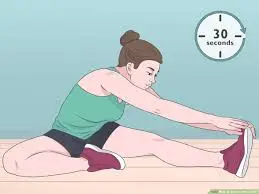
Steps To Follow:
- Stretch your legs out in front of you while seated, pointing your toes upward.
- Bring the left foot inside the right thigh and bend the left knee.
- Sliding the hands towards the ankle, slowly pivot forward from the hips. Strive to keep your back flat.
- Try to extend yourself, but don’t push yourself to the point of discomfort.
- Resuming an upright posture after a few seconds of holding, repeat.
- Switch sides.
Supine Hamstrings Stretch
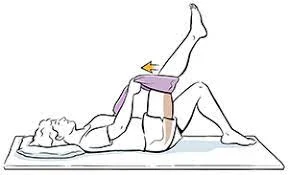
Steps To Follow:
- Lay flat on your back in a doorway or next to a corner of a wall.
- One leg should be raised to rest on the wall, while the other leg should be flat on the floor just beyond the wall’s edge.
- Without raising the hips, the back of the lifted leg should be as close to the wall as feasible. Stretch your arms out to each side of your body and point your toes.
- Flex the foot of the outstretched leg gently so that the toes point in the direction of the body.
- Avoid exerting yourself until it hurts. A strap or band can be used to help with the stretch if needed.
- After a few seconds of holding, go back to the beginning and repeat.
- Switch sides.
Seated Toe Touches
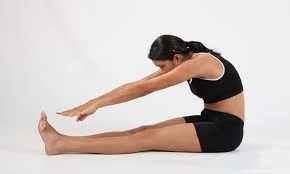
Steps To Follow:
- Stretch your legs out in front of you while seated, pointing your toes upward.
- Avoid bending your knees.
- Bend forward from the hips gradually while sliding the hands towards the ankles.
- Avoid straining yourself to the point of pain and try to keep your back flat.
- Resuming an upright posture after a few seconds of holding, repeat.
Hamstring isometrics
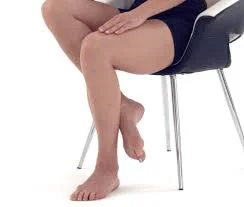
Steps To Follow:
- Stretch the wounded leg to a little more than 90 degrees while seated in a chair.
- To gently contract the hamstring, press your heel into the ground.
- Hold on for a few moments.
- Continue on the opposite side.
Hamstring curls
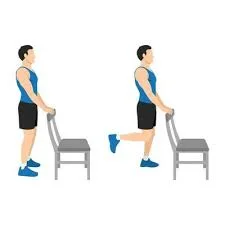
Steps To Follow:
- Bend your knee to bring your heel back towards your tailbone while you stand in front of a chair.
- Hold on for a few moments.
- For the intermediate level, bend the knee after looping one end of the band of resistance around the ankle and the other end around the chair leg.
- Continue on the opposite side.
Upside downcycling
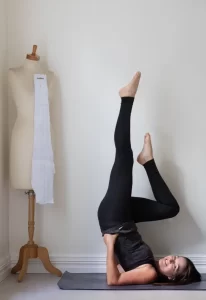
Steps To Follow:
- With your legs straight up towards the ceiling and your feet gently pointed, lie flat on your back.
- After centering yourself with a deep breath, raise your legs above your torso and raise your spine, one vertebra at a time, gently exhaling.
- To support your pelvis, place your hands behind it while maintaining your upper arms and elbows on the floor.
- Raise your legs to a height of ninety degrees from the floor.
- Raise your left leg to your chest and extend your right leg to the floor.
- Lower your heel to your buttocks and flex your right knee.
- You should have the sensation of riding an inverted bike.
- Raise your left leg straight, drop your left heel towards your buttock, and bring your bowed right leg forward.
- After straightening and bringing the legs back together, progressively sag the spine to the ground.
- Return to your neutral position after that.
- Then relax.
- Repeat these instructions five to 10 times.
Lying Crossover Stretch
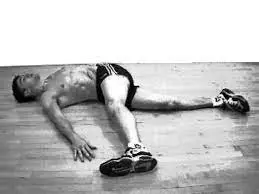
Steps To Follow:
- Arms relaxed, place them by your sides while you lie on your back.
- Flex your left leg and plant your left foot firmly on the ground.
- Until your body forms a cross or the letter “T,” spread your arms widely.
- Lower your left leg over your right and tilt your head to the left.
- Try to keep your upper back level with the ground.
- Hold this position for a brief period of time.
- Then, go back to your neutral position.
- Next, unwind.
- Continue with the opposite leg.
Hamstring Curls with Resistance Band
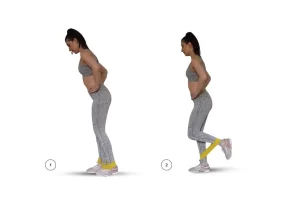
Steps To Follow:
- After positioning yourself in the middle of the looped band, around the opposite ankle with the remaining end.
- Assume a tall posture and contract your core.
- Stretch the bandaged leg backward while keeping the knee straight.
- Slowly bend your ankle such that it faces your glute.
- clenching your glutes and hamstrings.
- For a brief period, maintain your posture in this manner.
- Then, go back to your neutral position.
- Next, unwind.
- Continue with the opposite leg.
- Continue the above instructions five to 10 times.
Lunge With Medicine Ball Pass
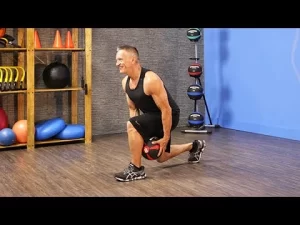
Steps To Follow:
- Stand with your feet wide apart and the ball near to your chest.
- Bend both knees and drop yourself into a lunge while you move the ball to the inner of your front leg simultaneously and pass it quickly from hand to hand beneath your thigh.
- Pass the ball back over your leg and straighten both of your legs.
- That is equivalent to one rep.
- Complete stages 5–10, then unwind.
- Proceed to the other side.
Leg Press on the Ball
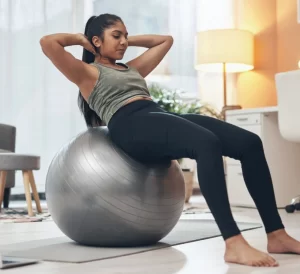
Steps To Follow:
- Sit on a large exercise ball.
- Move your feet outside until your upper body is angled over the ball.
- Your head and shoulders will be off the ball.
- Keep your head down and your neck in its natural position.
- Arms by your sides, that is.
- Bend your knees as though you were ready to do a squat.
- Next, focus on tightening your hamstrings as you push through your heels to return to the starting position.
- Hold on to the position for a short while.
- Return to your neutral position after that.
- Then relax.
- Five to ten times over, repeat these processes.
Sitting Heel Dig
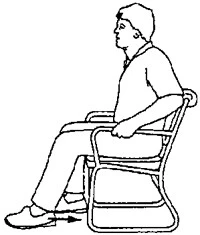
Steps To Follow:
- Sit on the forward edge of your bed or chair.
- Putting your heel on the ground, extend your right leg first, then ascend to the opposite leg.
- You then bring your heel back in your direction.
- The harder you press your heel into the ground, the more your muscles will contract.
- Start off slowly and gradually apply more pressure.
- Then, go back to your neutral posture.
- Then relax.
- Do five to ten alternate repetitions on each leg.
Standing kickbacks
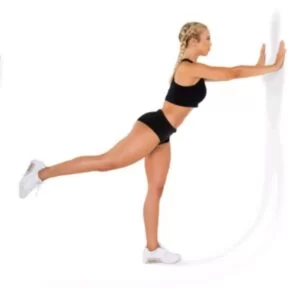
Steps To Follow:
- Put your palms up against a box, counter, or wall that is one to two feet away from you.
- With your left foot off the ground and your knee bent, slant slightly forward.
- Make sure your back is straight and your core is taut.
- As you extend your leg backward at an angle of 60 to 90 degrees, contract your glutes.
- Hold this position for a few seconds.
- Return your leg to its original position. One rep is awarded for this.
- Then relax.
- Do five to ten alternate repetitions on each leg.
Standing Toe Touches
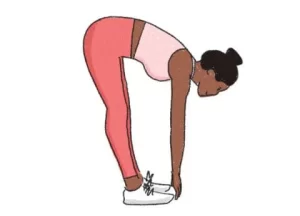
Steps To Follow:
- Put your feet shoulder-width apart and stand up straight with your toes pointed front.
- Keep your knees slightly bent, your legs straight, and your arms down by your sides.
- This is the appropriate place for you to begin.
- With your body relaxed, bend forward at the torso and let your fingers dangle down towards your toes.
- After a few counts of holding, take a step back to where you were before.
- Then relax.
- Do five to ten alternate reps of each leg.
Swiss Ball Hamstring Curl
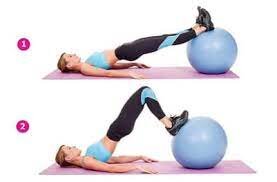
Steps To Follow:
- Place a Swiss ball beneath your feet and lie on your back.
- Keep your palms flat on the ground and your hands by your sides.
- Raise your upper body off the ground.
- This is where it all begins.
- Place your feet with the soles facing up.
- Both of your legs should be fully extended.
- To get the Swiss ball closer to your hips, bend your legs inward.
- Stretch your legs and carefully roll the Swiss ball back to the starting position.
- Proceed to your neutral position after that.
- Next, relax.
- Repeat five to ten more times.
Calf stretch
Steps To Follow:
- Facing the wall, place your hands on it.
- Grasping the back of a chair or counter with your hands is another method to achieve this.
- Bring one leg approximately a step behind the other by bringing your toes forward.
- Bend your front knee while maintaining a straight rear leg and a grounded heel.
- Bring your hips and chest towards the wall very slowly, unless you feel a strain in the calf of your rear leg.
- After holding for a few counts, return to your previous position.
- Next, unwind.
- Perform five to ten alternating repetitions for every leg.
Bulgarian Split Squat
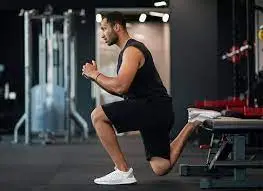
Steps To Follow:
- As you stand, place your back on your “bench.”
- With your left foot on the ground a few feet in front of the right foot, plant the top of your right foot, shoelaces down, on the bench.
- Make sure your core is engaged and your hands are calm.
- You can also choose to hold your hands by your sides or clasp them together at your chest, whichever seems most comfortable for you.
- Bend your knees to enter the split squat position.
- The optimum position is for your left knee to form a 90-degree angle with your thigh parallel to the ground, and your right knee to be raised above the floor.
- Push through your left heel to take yourself back to the starting position.
- Proceed to your neutral position after that.
- Next, unwind.
- After completing the five to ten repetitions, switch sides and proceed.
Prone knee bend
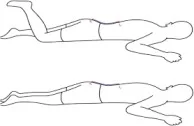
Steps To Follow:
- With your back to the ground, lie on a mat.
- Fold your arms across your body.
- Keep your trunk and legs at ease.
- Lay your left leg flat on the mat and slowly, pleasantly, bend your right leg as high as you can.
- For the duration of the exercise, try to keep your hips in a solid position.
- Raise your left leg in tandem with lowering your right.
- For each leg, repeat this five to ten times, alternating the leg movements with caution and gentleness.
- Return to the starting point.
Lunge
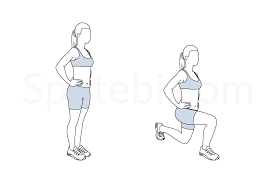
Steps To Follow:
- Starting from a standing stance, place your feet hip-width apart.
- Step forward more slowly than you would when walking, putting one leg in front of you and the other behind you.
- Throughout the entire process, your foot should remain flat on the ground.
- The heel on your back will come off the ground.
- Bend your knees to a roughly 90-degree angle as you descend.
- Do not forget to keep your trunk upright and your core engaged.
- To return to the starting stance, push off strongly with your front leg after that.
- Then relax.
- Five to ten times a day should be dedicated to this workout.
Chair walks
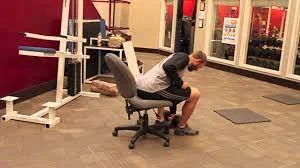
Steps To Follow:
- Sit in a movable office chair on a level surface.
- Stretch your leg slowly.
- To move the body and chair forward, hold onto the chair and dig your heel into the floor.
- Continue on the opposite side.
Hip Adduction- Ball Squeezes
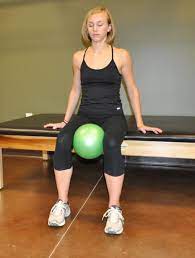
Steps To Follow:
- Put yourself in a tall stance at the end of a bench with your shoulders back, chest out, and back straight.
- Put your feet level on the ground and bend your knees.
- Place a ball between your knees.
- To squeeze the ball, try bringing your knees closer together.
- Give it some time to settle in.
- Put the ball back in your hands and bend your knees to where you started.
- After that, adopt an impartial attitude.
- Then relax.
- Five to ten times, repeat.
Single-leg floor touches
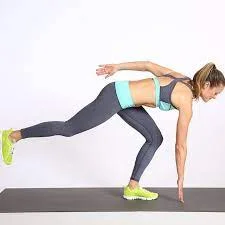
Steps To Follow:
- Bend from the hip and reach slowly down towards the ground while standing on one leg with the knee slightly bent.
- Get back to your standing position.
- Throughout the workout, maintain a straight torso.
- Continue on the opposite side.
Conclusion
Muscle strains are common ailments of the hamstrings. Though there are more advanced methods like cryotherapy, the RICE method of rest, ice, compression, and elevation is usually effective in treating them.
Strengthening and extending the muscle might help it recuperate once it’s ready. It’s critical to adhere to a physician’s rehabilitation plan and schedule follow-up appointments with physical therapists.
The modified hurdler’s stretch, the supine hamstring stretch, and seated toe touches are a few hamstring stretches. Moreover, eccentric activities for the hamstrings and hip extensors can support hamstring strength during recovery.
FAQs
Rest: Give your leg as much rest as you can. Ice: Apply ice packs to your hamstring for up to 20 minutes every two to three hours during the day (a tea towel wrapped around a bag of frozen peas would also work).
Resting the muscle is crucial for a speedy recovery of your hamstring. During the healing period, it is important that you gradually increase the amount of time you spend exercising by activating your hamstring muscles. You may also ice your leg to lessen discomfort and swelling in order to heal more quickly.
Stretching the hamstrings and wall
Place your healthy leg through the open doorway while lying on your back in a doorway. To straighten your knee, slide the leg that is afflicted up the wall. A slight stretch along the back of your leg should be felt. To start, hold the stretch for a minimum of one minute.
Light stretches and workouts
Resuming intense exercise too soon may exacerbate your injury. However, if you stop exercising too soon, scar tissue will grow around the rupture and your hamstring muscles will weaken. After a few days, you should begin doing light hamstring stretches to prevent this.
Light hinging is achievable a few days or a week or so after the initial injury in cases of grade 1 or lesser grade 2 hamstring injuries. Since squatting can lead to issues, try this work out cautiously.
References
- Hamstring Strain. (n.d.). Physiopedia. https://www.physio-pedia.com/Hamstring_Strain
- Hamstring Strain: Rehab Exercises | Kaiser Permanente. (n.d.). Kaiser Permanente. https://healthy.kaiserpermanente.org/health-wellness/health-encyclopedia/he.hamstring-strain-rehab-exercises.bo1577
- Monte, M. (2023, February 28). What are hamstring rehab exercises? https://www.medicalnewstoday.com/articles/hamstring-rehab-exercises
- Bariya, D. (2024, January 28). 36 Best Exercises For Pulled Hamstring Muscles. Mobile Physiotherapy Clinic. https://mobilephysiotherapyclinic.in/best-exercises-for-pulled-hamstring-muscles/

